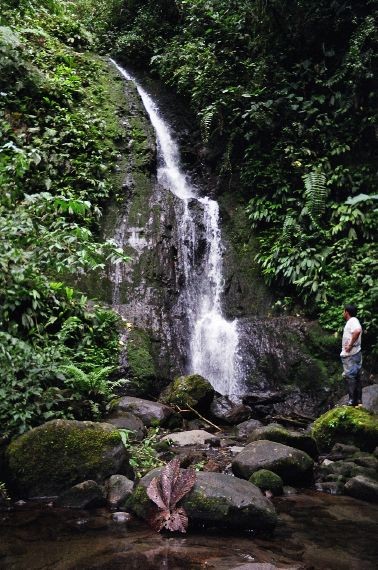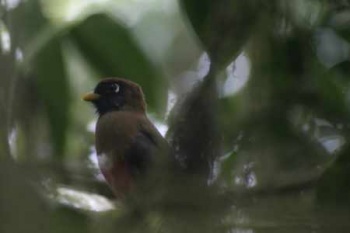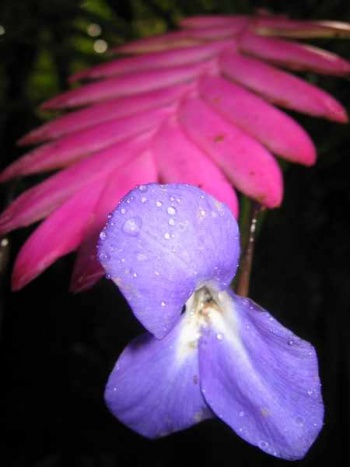m (→History and Use: Grammar/spelling) |
(→Access and Facilities: Tidy-up text) |
||
| Line 74: | Line 74: | ||
BY BUS | BY BUS | ||
| − | Take a bus from the Terminal Terrestre bus station in Quito- any bus bound for Pacto, Puerto Quito, San Miguel de los Bancos or Mindo is ok. | + | Take a bus from the Terminal Terrestre bus station in Quito - any bus bound for Pacto, Puerto Quito, San Miguel de los Bancos or Mindo is ok. |
| − | When the bus reaches Nanegalito tell the driver | + | |
| + | When the bus reaches Nanegalito tell the driver to stop at Km72 (Primero de Mayo). Advance arrangements can be made to pick you up from there. | ||
BY CAR | BY CAR | ||
Leave Quito on the new highway to Esmeraldas via Calacali | Leave Quito on the new highway to Esmeraldas via Calacali | ||
| − | Travel to km 72 (some | + | Travel to km 72 (some hundred meters before Km72 You'll see a big sign indicating Pachijal Reserva). At Km72 turn right and follow the road for 3 km until reaching the sign at the entrance to the reserve. |
TRANSFER SERVICE | TRANSFER SERVICE | ||
| − | + | Advance arrangements can be made for visitors to be collected from Quito or elsewhere | |
| − | |||
| − | |||
| − | |||
| − | |||
| − | |||
| − | |||
| − | |||
| − | + | ECO & BIRDING LODGE | |
| − | + | A jungle lodge with a foot inside the wood which has been built around some existing trees. Up to nineteen people can be accommodated in single, double or 4-bedded en-suite rooms | |
| − | |||
===Contact Details=== | ===Contact Details=== | ||
Revision as of 15:02, 11 December 2008

Overview
Reserva Ecologica Pachijal is located near the village of Mindo, 70km far from Quito. the site is easily reachable thru a new paved road.
Mindo is a 2-hour drive from Quito. It is also served by various public bus companies and taxi service. The roads are good, but 4-wheel drive is recommended to avoid the inevitable rocks and pot holes. The valley and nearest mountains have an elevational range between 1200-1600 meters. Mindo is subtropical forest (Cloud Forest) and is ideally situated at mid-slope, between the upper temperate zone and the lower humid tropical forests. The climate is mild year-round. The main rainy season is March-April, although some rain is likely throughout the year. The sunniest months are June- September, the time of year considered summer.
Mindo lies within the Chocó Endemic Bird Area (EBA) and Chocó Biogeographic Region, which is considered one of the world's richest biogeographic areas. This area "supports the largest number of restricted-range birds of any EBA in the Americas, over 50 species being endemic to the area...[and there is] relatively little known about the precise distributions, altitudinal movements and ecological requirements of the restricted-range birds..." p 202, Endemic Bird Areas of the World, 1998, BirdLife International. Over 30 Chocó endemic bird species are regularly found in a 3-4 day visit in the Mindo area.
Due to its critically important role in the conservation of numerous rare and endemic species, Mindo was designated South America's first Important Bird Area (IBA) by BirdLife International (1997). Mindo is an area of historic ornithological studies, where early collectors and ornithologists discovered or collected many species.

Birds
Notable Species
Favorite birding months are September-January as many northern and austral migrants are present in the Mindo area, as well as such local specialties as Yellow-collared Chlorophonia and Club-winged Manakin. However, many resident species, such as antpittas, are more active and easier to see in the rainy season.
There are three different habitats:
Forest altered by humans, here one can watch, among others: Roadside Hawk, Barred Forest Falcon, Variable Seedeater, Band-tailed Seedeater, Yellow-bellied Seedeater, Hooded Siskin, Yellow-faced Grassquit, Rufous Collared Sparrow, Smooth-billed Ani, Tropical Kingbird.
Secondary Forest with, among others: Crimson Rumped Toucanet, Pale Mandibled Aracari, Toucan Barbet, Blue-winged Mountain Tanager, Black-chinned Mountain Tanager, Scaled Fruiteater (rare).
Primary Forest with, among others: Dark-backed Wood Quail (rare), Wattled Guan (threatened), Yellow Breasted Antpitta (threatened), Andean Solitaire.
Rarities
Least Grebe , Osprey, Gray-backed Hawk, Semiplumbeous Hawk, Plumbeous Hawk, Gray Hawk, Short-tailed Hawk, Black-and-chestnut Eagle, Black Hawk-Eagle, Tiny Hawk, Plain-breasted Hawk, Bicolored Hawk, Plumbeous Forest Falcon, Peregrine Falcon, Rufous-bellied Seedsnipe, Solitary Sandpiper, Noble Snipe, Imperial Snipe, Common Snipe, Herring Gull, Laughing Gull, Maroon-chested Ground Dove, Pallid Dove, Chestnut-fronted Macaw, Blue-fronted Parrotlet, Rose-faced Parrot, Red-lored Amazon, Scaly-naped Amazon, Gray-capped Cuckoo, Groove-billed Ani, Foothill Screech Owl, Barn Owl, Crested Owl, Spectacled Owl, Stygian Owl, Oilbird, White-tipped Sicklebill, Tooth-billed Hummingbird, Little Woodstar, Black-breasted Puffleg, Rainbow-bearded Thornbill, Black-throated Trogon, Northern Violaceous Trogon, Crimson-bellied Woodpecker, Great Jacamar, White-whiskered Puffbird, Red-billed Scythebill, Brown-billed Scythebill, Northern Barred Woodcreeper, Double-banded Graytail, Ruddy Foliage-gleaner, Uniform Treehunter, Fasciated Antshrike, Great Antshrike, Russet Antshrike, Spot-crowned Antvireo, Rufous-rumped Antwren, Checker-throated Antwren, Griscom's Antwren, White-backed Fire-eye, Plain-backed Antpitta, Tawny Antpitta, Ocellated Tapaculo, Unicolored Tapaculo, Greenish Elaenia, Cinnamon Flycatcher, Pacific Flatbill, Fulvous-breasted Flatbill, Olive-sided Flycatcher, Eastern Wood Pewee, Acadian Flycatcher, Orange-crested Flycatcher, Vermilion Flycatcher, Yellow-bellied Chat Tyrant, Bright-rumped Attila, Rufous Mourner, Olivaceous Piha, Fork-tailed Flycatcher, Red-crested Cotinga, Black-tipped Cotinga, Green and Black Fruiteater, Barred Fruiteater, Long-wattled Umbrellabird, Red-capped Manakin, Blue-crowned Manakin, Gray-breasted Martin, Stripe-throated Wren, Black Solitaire, Spotted Nightingale Thrush, Slaty-backed Nightingale Thrush, Dagua Thrush, Pale-vented Thrush, Bay-breasted Warbler, Blackpoll Warbler, American Redstart, Highland Hepatic-Tanager, Rufous-chested Tanager, Yellow-throated Bush Tanager, Yellow-green Bush Tanager, Streaked Saltator, Saffron Finch
Check-list
Birds you can see here include:
Turkey Vulture, Black Vulture, Swallow-tailed Kite, Double-toothed Kite, Roadside Hawk, American Kestrel, Sickle-winged Guan, Dark-backed Wood Quail, Pale-vented Pigeon, Common Ground Dove, White-tipped Dove, Maroon-tailed Parakeet, Bronze-winged Parrot, Black-and-White Owl, Smooth-billed Ani, Shining Sunbeam, Great Sapphirewing, Sword-billed Hummingbird, Black-tailed Trainbearer, Collared Inca, Buff-winged Starfrontlet, Sapphire-vented Puffleg, Tyrian Metaltail, Rainbow Bearded Thornbill, Tawny-bellied Hermit, Purple-bibbed Whitetip, Speckled Hummingbird, Booted Racket Tail, Purple-throated Woodstar, Fawn-breasted Brilliant, Rufous-tailed Hummingbird, Andean Emerald, Brown Inca, Violet-tailed Sylph, Buff-tailed Coronet, Velvet Purple Coronet, Masked Trogon, Golden-headed Quetzal, Turquoise Jay, Toucan Barbet, Plate-billed Mountain Toucan, Pale-mandibled Aracari, Crimson-rumped Toucanet, Choco Toucan, Golden-olive Woodpecker, Smoky-brown Woodpecker, Strong-billed Woodcreeper, Tyrannine Woodcreeper, Montane Woodcreeper, Red-faced Spinetail, White-browed Spinetail, Scaly-throated Foliage-gleaner, Lineated Foliage-gleaner, Buff-fronted Foliage-gleaner, Pacific Hornero, Streak-capped Treehunter, Striped Treehunter, Giant Antpitta, Yellow-breasted Antpitta, Ornate Flycatcher, Torrent Tyrannulet, White-banded Tyrannulet, White-tailed Tyrannulet, Smoky Bush Tyrant, Smoke-coloured Pewee, Western Wood Pewee, Black Phoebe, House Wren, Streaked Tuftedcheek, Olive-striped Flycatcher, Dusky-capped Flycatcher, Golden-crowned Flycatcher, Cinnamon Flycatcher, Tropical Kingbird, Scaled Fruiteater, Andean Cock Of The Rock, Great Thrush, Glossy Black Thrush, Blue and White Swallow, Brown-bellied Swallow, White-collared Swift, Blackburnian Warbler, Slate-throated Whitestart, Tropical Parula, Spectacled Redstart, Blue-backed Conebill, Three-striped Warbler, Canada Warbler, Orange-bellied Euphonia, Masked Flowerpiercer, Glossy Flowerpiercer, Scarlet-bellied Mountain Tanager, Fawn-breasted Tanager, Golden Tanager, Flame-faced Tanager, Golden-naped Tanager, Beryl-spangled Tanager, Black-capped Tanager, Blue-winged Mountain Tanager, Hooded Mountain Tanager, Plushcap, Dusky Bush Tanager, Blue Grey Tanager, Yellow-bellied Seedeater, White-winged Brush Finch, Supercillied Hemispingus, Yellow-breasted Brush-Finch , Tricolored Brush-Finch, Rufous-collared Sparrow
Other Wildlife

The Cloud Forest is considered the richest ecosystem in the world, related to its biodiversity. In the Cloudforest you can see many species of orchids, bromelias, frogs, butterflies and mammals, among those we mention the Howling Monkey (endangered), the Bear, the Tigrillo.
At Pachijal they offer Cloudforest Wildlife Viewing packages, for details click on the following link [1]
For Birdwatching tours click on the link [2]
Site Information
Malaria, cholera and other tropical diseases have NOT been reported in Mindo.
History and Use

Reserva Ecologica was founded by two Italian friends and is driven by the following motivations:
the wish to give a little contribution to environmental conservation with about 100ha of primary forest.
the pleasure to place it at your disposal so that you can enjoy it.
the will to demonstrate that nature can be a source of profit also when respected and protected
Reserva Ecologica Pachijal is located within Chocò and the Mindo-Nambillo Reserve, which means that it is inside a transition forest, between Low Mountain Cloud Forest and Subtropical Forest; making it possible to meet species from both environments living together inside the Reserve. The great amount of food (fruit and seeds) available all year around makes Pachijal a great place for avifauna.
Areas of Interest

Reserva Yanacocha [3]
Ecorouta el Paseo del Quinde [4]
Mindo Cloud Forest [5]
Lek of the Cock-of-the-Rock
Antpittas place
Milpe Bird Sanctuary [6]
Rio Silanche Bird Sanctuary [7]
Access and Facilities
BY BUS
Take a bus from the Terminal Terrestre bus station in Quito - any bus bound for Pacto, Puerto Quito, San Miguel de los Bancos or Mindo is ok.
When the bus reaches Nanegalito tell the driver to stop at Km72 (Primero de Mayo). Advance arrangements can be made to pick you up from there.
BY CAR
Leave Quito on the new highway to Esmeraldas via Calacali Travel to km 72 (some hundred meters before Km72 You'll see a big sign indicating Pachijal Reserva). At Km72 turn right and follow the road for 3 km until reaching the sign at the entrance to the reserve.
TRANSFER SERVICE
Advance arrangements can be made for visitors to be collected from Quito or elsewhere
ECO & BIRDING LODGE
A jungle lodge with a foot inside the wood which has been built around some existing trees. Up to nineteen people can be accommodated in single, double or 4-bedded en-suite rooms
Contact Details
External Links
- Reserva Ecologica Pachijal website [8]



